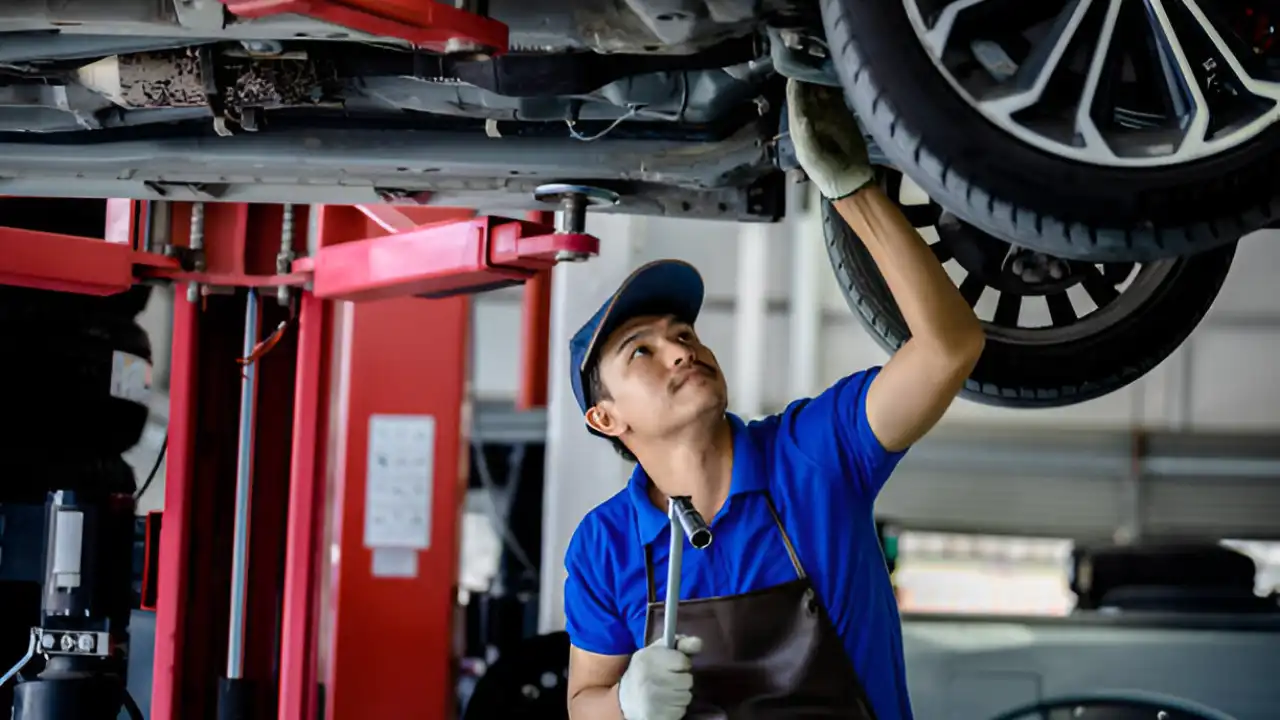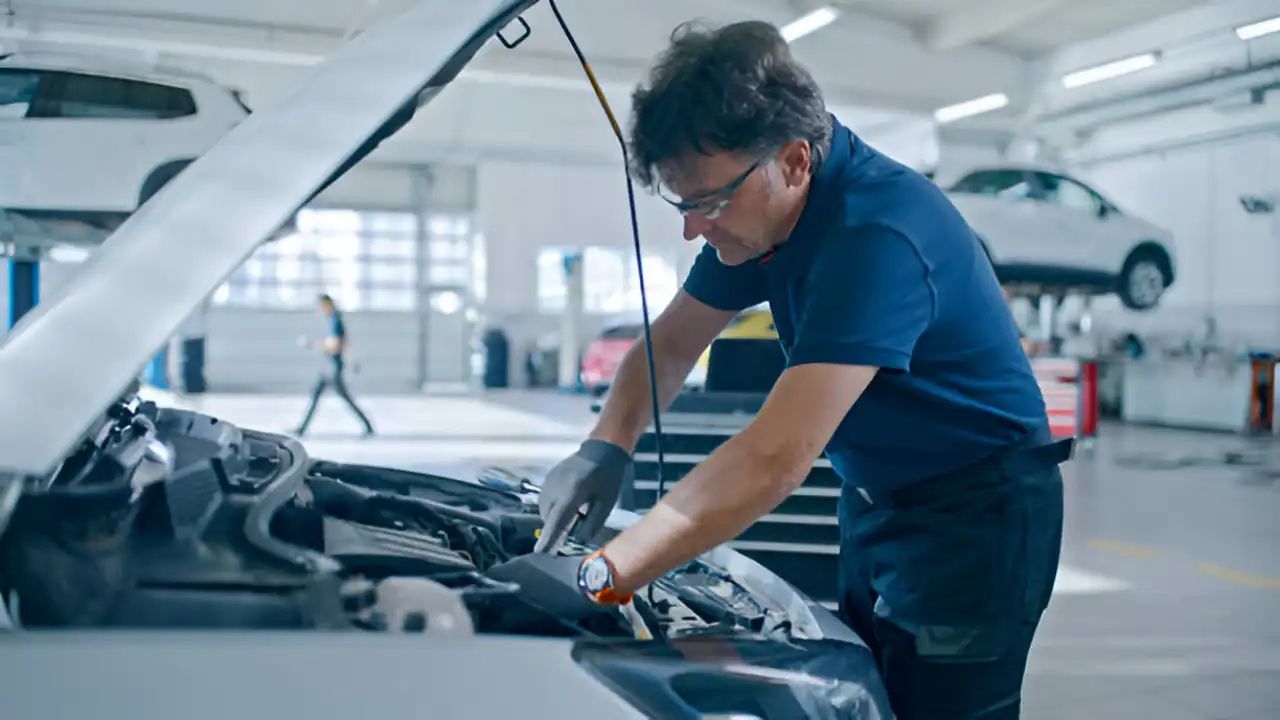Keeping your car running smoothly isn’t just about avoiding costly repairs; it’s about staying safe, saving money, and extending your vehicle’s lifespan. Yet with so many opinions online, many drivers still wonder: what’s the right maintenance schedule for my car?
Let’s simplify that.
How Often Should You Schedule General Car Maintenance?
You should schedule general car maintenance every 6 months or 5,000 to 7,500 miles, whichever comes first. However, always follow your vehicle’s owner’s manual, as maintenance needs vary by make, model, and driving conditions.
Understanding Mileage-Based Maintenance Intervals
Most modern vehicles are built with maintenance milestones in mind. Here’s a common breakdown:
- Every 5,000–7,500 miles: Oil and filter change, tire rotation, basic fluid top-offs, brake inspection
- Every 15,000–30,000 miles: Air filter replacement, fuel system cleaning, transmission fluid check
- At 60,000+ miles: Brake fluid flush, timing belt or chain inspection, spark plug replacement, coolant flush
These intervals are approximate. Always consult your vehicle’s OEM service guide; it accounts for your specific engine type, fluid capacity, and component wear expectations.
Why Routine Maintenance Matters More Than Repairs
A few days ago, a customer came into Briantire Service Workshop with a car that had been struggling to start smoothly and showed signs of poor fuel economy. After a quick inspection, we found the oil hadn’t been changed in over 10,000 miles. It had turned into sludge, clogging up vital engine components. The result? Nearly $1,500 in engine-related repairs.
When we explained the issue, the customer admitted they kept putting off routine services because the car seemed “fine.” But like we always say, problems don’t show up until damage is already done.
That visit turned into a valuable lesson. The customer now comes in regularly for oil changes, fluid top-ups, and tire checks. Since then, their car has been running smoother, more efficiently, and they haven’t had a single unexpected breakdown.
Preventative maintenance isn’t just about avoiding big repair bills; it’s about keeping your vehicle safe, reliable, and performing at its best.
Key Takeaway
Following your car’s factory-recommended maintenance schedule is one of the most effective ways to preserve performance, fuel economy, and resale value. Skipping even small tasks can lead to cumulative damage that’s far more expensive down the road.
How Often Should You Change Oil & Filters?
Oil is the lifeblood of your engine. It lubricates moving parts, reduces heat, and prevents wear by carrying away contaminants. But like any vital fluid, engine oil breaks down over time, especially under harsh driving conditions. That’s why knowing the right oil change interval is critical for engine health.
Conventional vs. Synthetic Oil: Know the Difference
If your vehicle uses conventional oil, the typical change interval is every 3,000 to 5,000 miles. This type of oil breaks down faster and is more prone to sludge buildup, especially in stop-and-go traffic or colder climates.
In contrast, synthetic oil offers better thermal stability and longevity. Most synthetic blends last between 7,500 and 10,000 miles, with some premium formulations exceeding 15,000 miles under optimal conditions. Synthetic oil also flows better at low temperatures and resists breakdown at high temperatures, making it ideal for modern engines.
What About the Oil Filter?
Every oil change should include a new oil filter. This small component captures metal shavings, dirt, and debris that circulate through your engine. A clogged filter can restrict oil flow, reducing lubrication and increasing engine wear. Replacing the filter along with the oil ensures a clean, consistent flow.
Checking Your Oil Between Changes
While your vehicle may have a set schedule, it’s wise to check your oil level monthly. Look for signs of dark or gritty oil, low levels, or a burning smell, all indicators that an earlier change might be necessary. Many vehicles now have oil life monitors, but nothing beats pulling the dipstick and checking manually.
A friend of mine once assumed synthetic oil meant he could ignore oil changes for a full year. Unfortunately, he forgot that short trips and idling during winter still degrade oil, even high-quality blends. His car started having performance issues after 9,000 miles, not because of the oil itself, but because his driving pattern called for more frequent changes.
That’s why it’s not just about the oil you use, but how you drive.
Routine Checks Every 3,000 to 10,000 Miles
Routine maintenance at regular intervals is essential for keeping your car in optimal condition. While oil and filter changes often steal the spotlight, there are several other systems and components that demand attention within the 3,000 to 10,000-mile range.
Tire Rotation and Pressure Checks
Your tires don’t wear evenly. The front and rear tires experience different loads and turning forces, which is why rotating them every 5,000 to 7,500 miles is key. This promotes even tread wear and extends tire life. Checking tire pressure monthly is equally important. Underinflated or overinflated tires can affect fuel economy, braking distance, and handling.

Brake Inspections
Brake pads wear gradually and silently until they don’t. Around every 6,000 to 10,000 miles, have your brake pads, rotors, and fluid inspected. Look out for signs like squealing, a soft brake pedal, or longer stopping distances. Even if the pads aren’t ready for replacement, catching uneven wear early can save you money on rotor repairs.
Fluid Top-Offs and Leak Checks
Beyond engine oil, your vehicle relies on several vital fluids that should be checked during routine visits:
- Brake fluid: should be clear and at the right level
- Transmission fluid: should be reddish and free of debris
- Coolant: regulates engine temperature; check for proper level and clarity
- Power steering fluid: if applicable, should be clean and full
Mechanics often include a multipoint inspection during oil changes, which makes it easy to catch minor issues before they become costly.
Windshield Wipers and Washer Fluid
It’s easy to forget how critical visibility is, until you’re caught in a downpour with streaky wipers. Wiper blades typically last about 6 to 12 months, depending on use and climate. At the same time, check and refill your washer fluid, especially before long trips or seasonal changes.
Battery Health and Terminal Cleaning
Batteries should be inspected every few months for corrosion, secure connections, and charge levels. Clean terminals and a simple voltage check can prevent you from being stranded by a dead battery.
According to EPA research, inspection-and-maintenance programs consistently improve fuel economy, often offsetting any added cost, especially for older vehicles.
The 30,000/60,000/90,000-Mile Maintenance Milestones
While routine checks keep your car running in the short term, long-term vehicle health depends on adhering to major service milestones—typically at 30,000, 60,000, and 90,000 miles. These aren’t just arbitrary numbers; they correspond to wear patterns in key components that degrade predictably over time.
30,000 Miles: Air Systems and Fuel Health
At around 30,000 miles, it’s time to inspect and often replace your:
- Engine air filter: Keeps debris out of the combustion chamber
- Cabin air filter: Maintains air quality inside the vehicle
- Fuel filter: Protects fuel injectors from contaminants
This is also a good point to clean the fuel system to maintain engine performance and fuel economy. Many manufacturers recommend inspecting hoses and belts for early signs of wear at this stage.
60,000 Miles: Fluids, Belts, and Spark Plugs
The 60,000-mile mark is one of the most service-intensive milestones. Common tasks include:
- Spark plug replacement: Worn plugs can lead to misfires and fuel inefficiency
- Brake fluid flush: Absorbs moisture over time, reducing braking performance
- Coolant flush: Prevents overheating and protects against corrosion
- Transmission fluid service: Maintains shifting smoothness and prevents transmission wear
- Drive belts/serpentine belts: Begin to show signs of cracking and should be inspected or replaced
Even if the vehicle seems to be running smoothly, neglecting these services can accelerate engine wear or even lead to breakdowns.
90,000 Miles: Timing Components and Deep System Checks
At 90,000 miles, most cars require another round of fluid flushes, along with deep inspections of key mechanical systems. In addition:
- Timing belt: If your car uses a belt rather than a chain, this is often the critical replacement interval. A failed belt can cause catastrophic engine damage.
- Water pump: Often replaced alongside the timing belt as a preventative measure
- Differential fluid: For rear-wheel or all-wheel drive vehicles, this lubricates the gears and prevents drivetrain damage
This is also the time for a comprehensive inspection—brakes, suspension, steering components, and emissions systems should all be evaluated.
Why These Intervals Matter
These milestone services aren’t just dealer suggestions; they’re backed by engineering. Components like coolant and brake fluid degrade chemically over time, and even durable parts like belts and plugs have finite lives. Skipping them doesn’t just risk performance; it risks your safety and the longevity of your vehicle.
Real-World Insight
A client I once worked with came in for a major issue at 95,000 miles. His timing belt had never been replaced, and unfortunately, it snapped on the highway, causing a complete engine failure. The repair cost was nearly the value of the car. Had he followed the OEM-recommended schedule, that could have been a $600 service instead of a $5,000 rebuild.
Treating these 30k, 60k, and 90k mile intervals as non-negotiable helps prevent sudden breakdowns, costly repairs, and unexpected downtime. Think of them as the cornerstone of responsible vehicle ownership
Seasonal Maintenance Tips for Year-Round Reliability
Changing seasons bring changing stressors for your vehicle. While it’s easy to assume your maintenance needs remain constant, temperature shifts, humidity, and road conditions can dramatically affect everything from fluid performance to battery life. Preparing your car for each season ensures safety, efficiency, and peace of mind.

Preparing for Winter: Cold Starts and Visibility
Cold weather puts additional strain on your vehicle’s battery and thickens fluids, making it harder for your engine to turn over and run efficiently. In colder months, engine oil becomes more viscous, so using the correct grade recommended for winter driving is essential. Windshield wipers and washer fluid also deserve attention, as frozen buildup or worn blades can compromise visibility during snow or sleet.
In many regions, tire pressure drops significantly in the winter. Even a few PSI lost can reduce traction on slippery roads, so checking and adjusting tire pressure frequently becomes a critical habit.
Getting Ready for Summer: Heat and Cooling System Stress
Summer brings its own set of challenges. High temperatures place your cooling system under considerable strain. Radiator hoses expand, coolant levels fluctuate, and your engine works harder to maintain safe operating temperatures. Overheating is one of the most common warm-weather breakdowns, and often it results from a neglected coolant flush or a cracked hose that went unnoticed.
Additionally, your car’s air conditioning system should be inspected before temperatures soar. A weak A/C unit is more than an inconvenience; it can signal refrigerant leaks or compressor wear, both of which are more expensive to repair when ignored.
Spring and Fall: Transitional Touchpoints
Spring and fall are excellent times for multi-point inspections, especially if you’ve just come out of a particularly hot or cold season. Spring is ideal for checking undercarriage damage from icy or salted roads, while fall calls for tire tread checks and battery tests to ensure readiness for colder starts. These transitional periods also offer a good opportunity to clean or replace cabin air filters, which often accumulate debris and allergens over time.
A Personal Routine That Works
Over the years, I’ve found that aligning my maintenance with the seasons has prevented countless minor issues from turning into bigger problems. Each spring, I make a checklist, including oil change, tire rotation, battery check, and a coolant inspection. It takes about an hour at the shop and a modest investment, but the results speak for themselves. I’ve avoided breakdowns on road trips, never had a winter no-start issue, and consistently passed emissions tests on the first try.
Seasonal Planning is Smart Planning
Adapting your maintenance schedule to the seasons helps you stay ahead of weather-related wear and tear. It’s not just about reacting to problems; it’s about proactive ownership, where your vehicle serves you reliably, no matter the forecast.
How Often Should You Take Your Car in for an Inspection?
Even if your car seems to be running smoothly, a professional inspection at least once a year is a smart move. Annual inspections serve as a safety net, catching hidden issues like worn brake pads, leaky hoses, or loose suspension components before they escalate into major repairs. They’re especially valuable if you don’t drive frequently; low mileage doesn’t mean your fluids, rubber parts, or seals aren’t aging.
Many shops offer multi-point inspections bundled with oil changes or seasonal service specials. These typically include checks on brakes, belts, battery, fluid levels, filters, lights, and tire condition. Think of it as a health checkup for your car; it may not feel necessary in the moment, but it helps preserve long-term performance and safety.
One customer I worked with came in for a simple tire rotation, and the technician spotted a cracked serpentine belt on the verge of failure. That $75 inspection saved her from a roadside breakdown and hundreds in emergency repairs.
Whether you’re a daily commuter or an occasional driver, inspections fill in the gaps between routine maintenance tasks. Done regularly, they ensure your car stays roadworthy and reliable, no matter what your dashboard tells you.
Avoiding Unnecessary Upsells: Trusting OEM Schedules
It’s no secret, many service centers push additional services that your car may not need. From early fluid flushes to overpriced filter swaps, upsells can inflate your maintenance bill without offering real benefits. The best defense? Stick to your vehicle’s OEM (Original Equipment Manufacturer) schedule, found in your owner’s manual.
OEM schedules are designed by the engineers who built your car. They account for wear rates, part quality, and fluid lifespans under typical driving conditions. If a mechanic recommends a service ahead of schedule, ask why, and compare it to your manual’s guidelines before agreeing.
Here’s a quick example of common upsell attempts vs. typical OEM recommendations:
| Service Type | Common Upsell Claim | OEM Recommendation |
| Transmission Fluid | Every 30,000 miles | 60,000–100,000 miles |
| Coolant Flush | Every 20,000 miles | 50,000–100,000 miles |
| Cabin Air Filter | Every oil change | Every 15,000–30,000 miles |
| Brake Fluid Flush | Every 12 months | Every 2–3 years |
One customer I spoke with was sold a transmission flush at 25,000 miles, completely unnecessary for her new vehicle. A simple check of her manual could’ve saved her $250.
Knowledge is power. When in doubt, go by the book.
Need Professional Maintenance You Can Trust?
If you’re ready to keep your car in top shape without the guesswork, visit Brian’s Tire & Service in Huntsville. Our expert technicians follow manufacturer-recommended maintenance schedules and never push unnecessary upsells. From oil changes and brake checks to full inspections and seasonal service, they’ve got your back.
Schedule your next service today, and drive with confidence.
Final Thoughts
Car maintenance doesn’t have to be overwhelming. By following your manufacturer’s recommended schedule, adapting to seasonal changes, and keeping an eye on key components between visits, you can keep your vehicle running reliably for years. Routine care isn’t just about saving money; it’s about safety, performance, and protecting your investment.
Whether you’re driving across town or planning a long road trip, a well-maintained car offers peace of mind and fewer surprises. Trust your owner’s manual, be cautious of unnecessary upsells, and take pride in proactive ownership.
In the long run, maintenance isn’t a chore; it’s smart insurance on your most-used machine.
Frequently Asked Questions
What happens if I delay regular car maintenance?
Delaying maintenance can lead to reduced fuel efficiency, increased wear on engine components, and potential safety issues. Small issues often become expensive repairs when ignored.
Is it okay to follow the oil life monitor instead of a mileage schedule?
Yes, for newer vehicles with oil life monitoring systems, it’s generally safe to follow that indicator. However, it’s still wise to check the oil level and quality manually every month.
How do I know if I’m under a “severe driving” schedule?
If you frequently drive in stop-and-go traffic, short trips under 5 miles, extreme temperatures, dusty roads, or tow heavy loads, you likely fall under a severe service schedule and may need more frequent maintenance.
Are dealership maintenance plans worth it?
They can be, especially for new vehicles under warranty. Just be sure the plan aligns with your owner’s manual and doesn’t include unnecessary early services.
Can I perform general car maintenance myself?
Absolutely. Tasks like checking fluids, replacing air filters, and changing wipers are DIY-friendly. Just ensure you use manufacturer-approved parts and follow instructions carefully.


